You might think of the explosive part of a nuclear weapon as the “weapon” or “bomb,” but in the technical literature it has its own kind of amusingly euphemistic name: the “physics package.” This is the part of the bomb where the “physics” happens — which is to say, where the atoms undergo fission and/or fusion and release energy measured in the tons of TNT equivalent.
Drawing a line between that part of the weapon and the rest of it is, of course, a little arbitrary. External fuzes and bomb fins are not usually considered part of the physics package (the fuzes are part of the “arming, fuzing, and firing” system, in today’s parlance), but they’re of course crucial to the operation of the weapon. We don’t usually consider the warhead and the rocket propellant to be exactly the same thing, but they both have to work if the weapon is going to work. I suspect there are many situations where the line between the “physics package” and the rest of the weapon is a little blurry. But, in general, the distinction seems to be useful for the weapons designers, because it lets them compartmentalize out concerns or responsibilities with regards to use and upkeep.
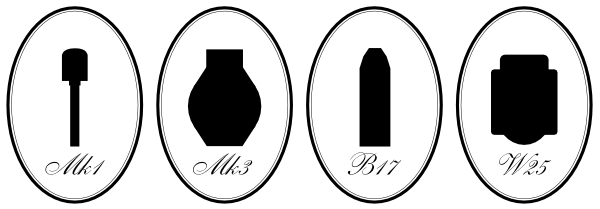
Physics package silhouettes of some of the early nuclear weapon variants. The Little Boy (Mk-1) and Fat Man (Mk-3) are based on the work of John Coster-Mullen. All silhouette portraits are by me — some are a little impressionistic. None are to any kind of consistent scale.
The shape of nuclear weapons was from the beginning one of the most secret aspects about them. The casing shapes of the Little Boy and Fat Man bombs were not declassified until 1960. This was only partially because of concerns about actual weapons secrets — by the 1950s, the fact that Little Boy was a gun-type weapon and Fat Man was an implosion weapon, and their rough sizes and weights, were well-known. They appear to have been kept secret for so long in part because the US didn’t want to draw too much attention to the bombing of the cities, in part because we didn’t want to annoy or alienate the Japanese.
But these shapes can be quite suggestive. The shapes and sizes put limits on what might be going on inside the weapon, and how it might be arranged. If one could have seen, in the 1940s, the casings of Fat Man and Little Boy, one could pretty easily conjecture about their function. Little Boy definitely has the appearance of a gun-type weapon (long and relatively thin), whereas Fat Man clearly has something else going on with it. If all you knew was that one bomb was much larger and physically rounder than the other, you could probably, if you were a clever weapons scientist, deduce that implosion was probably going on. Especially if you were able to see under the ballistic casing itself, with all of those conspicuously-placed wires.
In recent years we have become rather accustomed to seeing pictures of retired weapons systems and their physics packages. Most of them are quite boring, a variation on a few themes. You have the long-barrels that look like gun-type designs. You have the spheres or spheres-with-flat ends that look like improved implosion weapons. And you then have the bullet-shaped sphere-attached-to-a-cylinder that seems indicative of the Teller-Ulam design for thermonuclear weapons.
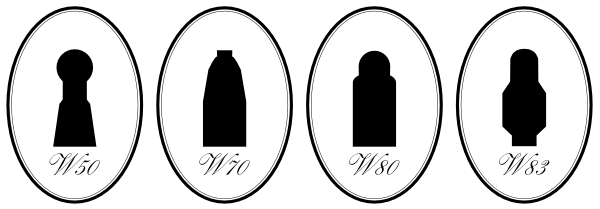
Silhouettes of compact thermonuclear warheads. Are the round ends fission components, or spherical fusion components? Things the nuke-nerds ponder.
There are a few strange things in this category, that suggest other designs. (And, of course, we don’t have to rely on just shapes here — we have other documentation that tells us about how these might work.) There is a whole class of tactical fission weapons that seem shaped like narrow cylinders, but aren’t gun-type weapons. These are assumed to be some form of “linear implosion,” which somewhat bridges the gap between implosion and gun-type designs.
All of this came to mind recently for two reasons. One was the North Korean photos that went around a few weeks ago of Kim Jong-un and what appears to be some kind of component to a ballistic case for a miniaturized nuclear warhead. I don’t think the photos tell us very much, even if we assume they are not completely faked (and with North Korea, you never know). If the weapon casing is legit, it looks like a fairly compact implosion weapon without a secondary stage (this doesn’t mean it can’t have some thermonuclear component, but it puts limits on how energetic it can probably be). Which is kind of interesting in and of itself, especially since it’s not every day that you get to see even putative physics packages of new nuclear nations.
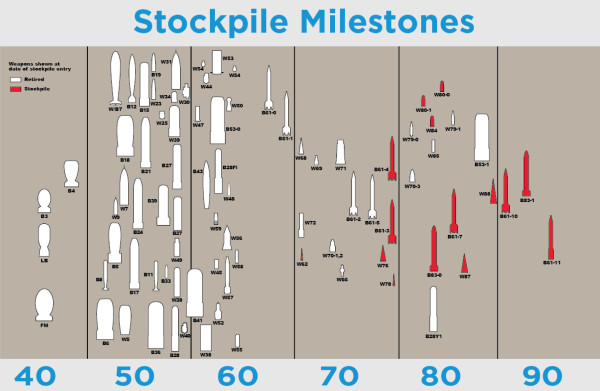
Stockpile milestones chart from Pantex’s website. Lots of interesting little shapes.
The other reason it came to mind is a chart I ran across on Pantex’s website. Pantex was more or less a nuclear-weapons assembly factory during the Cold War, and is now a disassembly factory. The chart is a variation on one that has been used within the weapons labs for a few years now, my friend and fellow-nuclear-wonk Stephen Schwartz pointed out on Twitter, and shows the basic outlines of various nuclear weapons systems through the years. (Here is a more up-to-date one from the a 2015 NNSA presentation, but the image has more compression and is thus a bit harder to see.)
For gravity bombs, they tend to show the shape of the ballistic cases. For missile warheads, and more exotic weapons (like the “Special Atomic Demolition Munitions,” basically nuclear land mines — is the “Special” designation really necessary?), they often show the physics package. And some of these physics packages are pretty weird-looking.
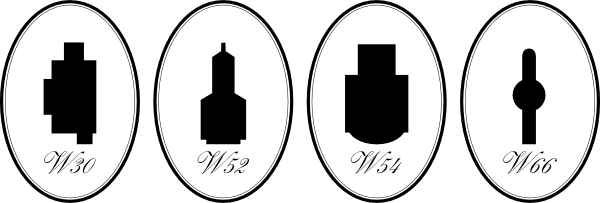
Some of the weirder and more suggestive shapes in the chart. The W30 is a nuclear land mine; the W52 is a compact thermonuclear warhead; the W54 is the warhead for the Davy Crockett system, and the W66 is low-yield thermonuclear weapon used on the Sprint missile system.
A few that jump out as especially odd:
-
In the Pantex version (but not the others), the W59 is particular in that it has an incorrectly-filled circle at the bottom of it. I wonder if this is an artifact of the vectorization process that went into making these graphics, and a little more indication of the positioning of things than was intended.
- The W52 has a strange appearance. It’s not clear to me what’s going on there.
- The silhouette of the W30 is a curious one (“worst Tetris piece ever” quipped someone on Twitter), though it is of an “Atomic Demolition Munition” and likely just shows some of the peripheral equipment to the warhead.
- The extreme distance between the spherical end (primary?) and the cylindrical end (secondary?) of the W-50 is pretty interesting.
- The W66 warhead is really strange — a sphere with two cylinders coming out of it. Could it be a “double-gun,” a gun-type weapon that decreases the distance necessary to travel by launching two projectiles at once? Probably not, given that it was supposed to have been thermonuclear, but it was an unusual warhead (very low-yield thermonuclear) so who knows what the geometry is.
There are also a number of warheads whose physics packages have never been shown, so far as I know. The W76, W87, and W88, for example, are primarily shown as re-entry vehicles (the “dunce caps of the nuclear age” as I seem to recall reading somewhere). The W76 has two interesting representations floating around, one that gives no real feedback on the size/shape of the physics package but gives an indication of its top and bottom extremities relative to other hardware in the warhead, another that portrays a very thin physics package that I doubt is actually representational (because if they had a lot of extra space, I think they’d have used it). 1
What I find interesting about these secret shapes is that on the one hand, it’s somewhat easy to understand, I suppose, the reluctance to declassify them. What’s the overriding public interest for knowing what shape a warhead is? It’s a hard argument to make. It isn’t going to change how to vote or how we fund weapons or anything else. And one can see the reasons for keeping them classified — the shapes can be revealing, and these warheads likely use many little tricks that allow them to put that much bang into so compact a package.
On the other hand, there is something to the idea, I think, that it’s hard to take something seriously if you can’t see it. Does keeping even the shape of the bomb out of public domain impact participatory democracy in ever so small a way? Does it make people less likely to treat these weapons as real objects in the world, instead of as metaphors for the end of the world? Well, I don’t know. It does make these warheads seem a bit more out of reach than the others. Is that a compelling reason to declassify their shapes? Probably not.
As someone on the “wrong side” of the security fence, I do feel compelled to search for these unknown shapes — a defiant compulsion to see what I am not supposed to see, perhaps, in an act of petty rebellion. I suspect they look pretty boring — how different in appearance from, say, the W80 can they be? — but the act of denial makes them inherently interesting.
- One amusing thing is that several sites seem to have posted pictures of the arming, fuzing, and firing systems of these warheads under the confusion that these were the warheads. They are clearly not — they are not only too small in their proportions, but they match up exactly to declassified photos of the AF&F systems (they are fuzes/radars, not physics packages).[↩]

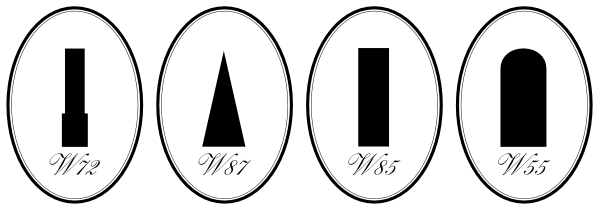


It is hard to understand why even today the external cases of warheads are kept secret. Certainly,nations that already have nuclear capability know very well how the physics of the weapon works.A photo of a bomb will not help any country to get a bomb.
I can’t find my copy of the book at the moment, but IIRC in John McPhee’s Curve of Binding Energy, bomb designer Ted Taylor, visiting the nuclear museum in Albuquerque, expressed surprise at some of the exhibits remarking, in paraphrase, “You can tell a lot about how these work just by looking at the shapes.”
Good memory!:
“I once visited the National Atomic Museum, in Albuquerque, with Ted Taylor. It had been open to the public since 1969, but he had never been there, and as we walked through the door he drew a shallow breath in sudden surprise. It was a hall of weapons, a long, high-ceilinged room filled with fission and fusion bombs. They were hanging from the ceiling and sitting on the floor—forty or fifty in all. A bomb called the Mark 61 was dangling from a drogue parachute. It was a cylinder about twelve feet long, and it had a diameter of one foot. A plaque near it read, “Yield of the Mark 61 is in the megaton range.”
‘Just looking at it tells you a great deal about the design of an H-bomb,’ Taylor said. ‘Wow. This place is really something.”
(The Curve of Binding Energy, 1994 reprint, p. 146)
Interesting stuff. Secrecy always seems to encourage the curious.
I wonder if the silhouettes are just the outer cases, including space for fuses and other parts.
Physics package vs the rest of the weapon may be a result of ownership. The physic package belongs to DOE, while the rest of the weapon is military, at least for maintenance.
The use of “special” (e.g. Special Atomic Demolition Munition) in regards to nuclear weapons was normal use, at least for the USAF. The F-4 flight manual has descriptions of “special stores”, and I wrote an audit report about “Special Weapons Documentation” (scary if you understood the process for moving special weapons).
I very dimly recall reading about something like an ‘open-ended’ dual-gun neutron bomb design where the critical masses where allowed to ‘eject’ shortly after reaching criticality with the goal to curb the explosive yield. It may have used Americium or some other ‘non-classical’ fission fuel. This was way before the internet age, probably in a popular-science type magazine.
That’s the first thing I thought of when I saw the W66 shape, and this was meant for an ABM, ‘designed to destroy or disable an incoming warhead using neutron flux’ (Wikipedia).
I remember to have read in a old science magazine a history about the Pantex working on the B-61 dismantling.I don´t know if the history is accurate,but it says that the B-61 primary is spherical,had 32 detonators and is lined with a special blanket that regulate the warhead´s temperature.
I recall visiting the National Atomic Museum, on Kirtland AFB, in the early 1970s, as a high school student escorted by my father, who worked for DASA/DNA Field Command. It was just a concrete-floor building, and many weapons mockups; much more than the current museum, which is now called the National Museum of Nuclear Science and is located off-base on Eubank and Southern. It’s a shame the museum has been “dumbed down” from its initial purpose of documenting nuclear weapons.
Several weeks ago, while on vacation, I visited the Titan II Missile Museum, south of Tucson, Arizona; there they have a mockup of the missile’s W53 warhead, which is a large, fat cylinder with a mushroom-shaped protrusion on one end; an illustration showed the warhead in the re-entry vehicle, mushroom end facing away from the nose. As I recall elsewhere about discussions of SLBM re-entry vehicles, the center of gravity of the vehicle needs to be as far forward as possible, for stability; this would imply that the main cylindrical body of the W53 has the most mass, as it’s facing toward the nose of the vehicle. I don’t know what the mushroom cap is for; possibly an oblate spheroid primary, or maybe contains a parachute? One can only speculate.
Joe V.